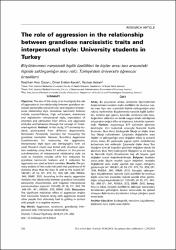| dc.contributor.author | Özcan, Neslihan Arıcı | |
| dc.contributor.author | Koçak, Ömer Erdem | |
| dc.contributor.author | Arslan, Reyhan | |
| dc.date.accessioned | 10.07.201910:49:13 | |
| dc.date.accessioned | 2019-07-10T20:01:36Z | |
| dc.date.available | 10.07.201910:49:13 | |
| dc.date.available | 2019-07-10T20:01:36Z | |
| dc.date.issued | 2018 | en_US |
| dc.identifier.citation | Özcan, N., Koçak, Ö. E. ve Arslan, R. (2018). The role of aggression in the relationship between grandiose narcissistic traits and interpersonal style: University students in Turkey. Turkish Journal of Clinical Psychiatry, 21(4), 341-350. https://dx.doi.org/10.5505/kpd.2018.85547 | en_US |
| dc.identifier.issn | 1302-0099 | |
| dc.identifier.issn | 2146-7153 | |
| dc.identifier.uri | https://dx.doi.org/10.5505/kpd.2018.85547 | |
| dc.identifier.uri | https://hdl.handle.net/20.500.12511/3359 | |
| dc.description | WOS: 000446739600003 | en_US |
| dc.description.abstract | Objective: The aim of this study is to investigate the role of aggression in the relationship between grandiose narcissistic personality characteristics and negative interpersonal relationship style. Grandiose narcissistic features include overconfidence, high self-esteem, dominance and exploitative interpersonal style, expectation of attention and admiration from others, and aggressive attitudes and behaviors through the concept of threatened egotism. Method: In this study, 577 university students participated from different departments. Narcissistic Personality Inventory for measuring the grandiose narcissistic features, Buss-Perry Aggression Questionnaire for measuring the aggression, Interpersonal Style Scale and demographic form are used. Research model was tested with structural equation modeling using Amos 21 software. In this process sub-dimensions of interpersonal relationship style are used as manifest variable while five indicators for grandiose narcissistic features and 3 indicators for aggression are used as latent variables. Results: The primary analysis of the study indicated that goodness-of-fit statistics show that the data fit well to the model (x(2): 180.801, df: 54, CFI: .976, TLI: .959, GFI: .958, RMSEA: .064, SRMR: .051). According to the results, aggression mediates the relationship between grandiose narcissistic personality characteristics and negative interpersonal communication styles (x(2): 259.405, df: 65, CFI: .963, TLI: .948 GFI: .941, RMSEA: .072, SRMR: .055). Discussion: The significant mediation effect of aggression implies that narcissistic features bring with aggression toward other people that ultimately lead to getting in contact with people in a negative manner. | en_US |
| dc.language.iso | eng | en_US |
| dc.publisher | Klinik Psikiyatri Dergisi | en_US |
| dc.rights | info:eu-repo/semantics/openAccess | en_US |
| dc.subject | Aggression | en_US |
| dc.subject | Narcissism | en_US |
| dc.subject | Grandiosity | en_US |
| dc.subject | Interpersonal Style | en_US |
| dc.subject | Interpersonal Relationships | en_US |
| dc.title | The role of aggression in the relationship between grandiose narcissistic traits and interpersonal style: University students in Turkey | en_US |
| dc.type | article | en_US |
| dc.relation.ispartof | Turkish Journal of Clinical Psychiatry | en_US |
| dc.department | İstanbul Medipol Üniversitesi, İşletme ve Yönetim Bilimleri Fakültesi, İşletme Bölümü | en_US |
| dc.department | İstanbul Medipol Üniversitesi, Eğitim Fakültesi, Eğitim Bilimleri | en_US |
| dc.authorid | 0000-0002-4649-2042 | en_US |
| dc.authorid | 0000-0001-9344-2059 | en_US |
| dc.identifier.volume | 21 | en_US |
| dc.identifier.issue | 4 | en_US |
| dc.identifier.startpage | 341 | en_US |
| dc.identifier.endpage | 350 | en_US |
| dc.relation.publicationcategory | Makale - Uluslararası Hakemli Dergi - Kurum Öğretim Elemanı | en_US |
| dc.identifier.doi | 10.5505/kpd.2018.85547 | en_US |
| dc.identifier.scopusquality | Q4 | en_US |


















